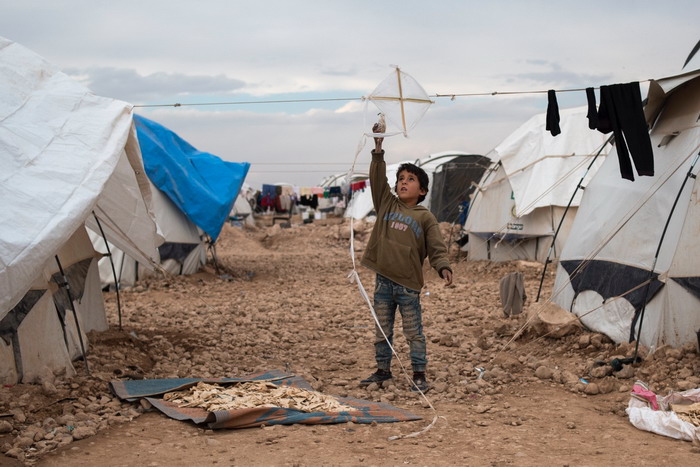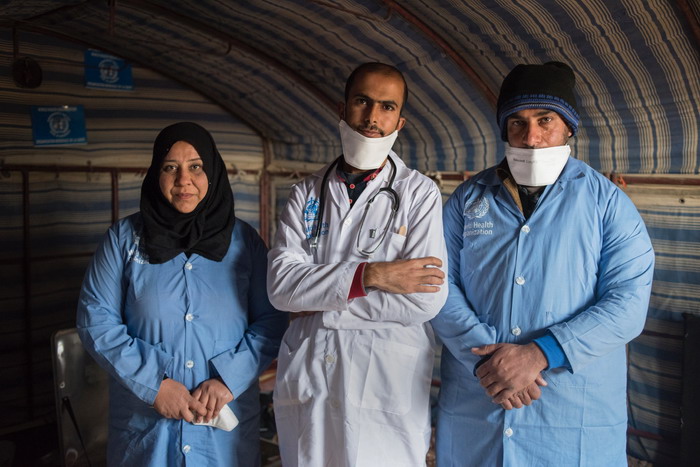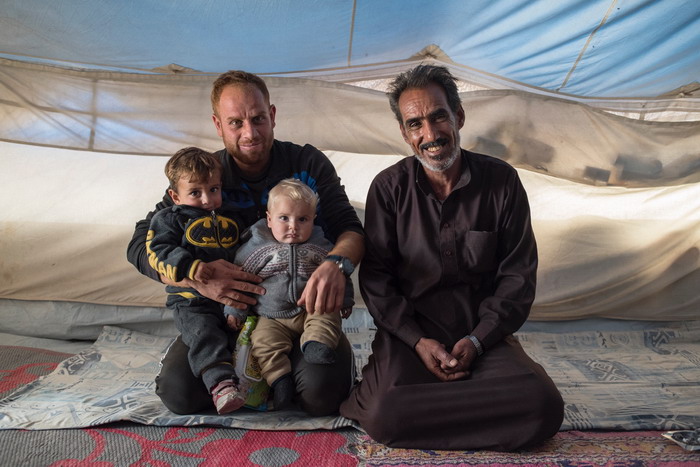WHO ramps up health support to camps in northeastern Syria in response to huge population movements
 A boy plays with a homemade kite in Ain Issa Camp31 January 2018 – Sitting on the uneven floor of his small white tent in a displacement camp in northeastern Syria, Nasser Ali Mousa can find only one way to describe what his family went through in Raqqa during years of ISIL occupation and in the fierce battle to dislodge the group from the city.
A boy plays with a homemade kite in Ain Issa Camp31 January 2018 – Sitting on the uneven floor of his small white tent in a displacement camp in northeastern Syria, Nasser Ali Mousa can find only one way to describe what his family went through in Raqqa during years of ISIL occupation and in the fierce battle to dislodge the group from the city.
“It was hell,” he says.
He looks at his grandson, Ra’ad, playing with a cherub-faced friend from the tent next-door. Ra’ad is wearing thick grey pants and a batman sweater.
“The children saw corpses and destruction and experienced hunger and disease,” he continues. “It was very hard.”
Because of the conflict, it took Nasser and his family one month to reach this camp on a rocky desert plain in Ain Issa, about 50 kilometres north of Raqqa.
Nasser and his family are among the 2.6 million Syrians who fled their homes for safer parts of the country last year. That’s about 7,700 displacements per day — one of the highest rates in the world. In total, after almost seven years of conflict, more than 6.1 million people are uprooted inside the country.
Much of the displacement in 2017 occurred in northeastern Syria as a result of anti-ISIL offensives in Raqqa and Deir al-Zor. Hastily constructed camps filled up quickly.
 Houriyah from Aleppo (left) Haitham from Raqqa (centre) and Nasser from Deir Ezzor work at a the mobile clinic in Ain Issa CampAs vulnerable families move around northeastern Syria, the World Health Organization (WHO) is moving with them, providing support in a variety of settings, including health centres in host communities, mobile medical teams and targeted vaccination campaigns. In camps like Ain Issa, WHO supports partner organizations to run both stationary and mobile health teams.
Houriyah from Aleppo (left) Haitham from Raqqa (centre) and Nasser from Deir Ezzor work at a the mobile clinic in Ain Issa CampAs vulnerable families move around northeastern Syria, the World Health Organization (WHO) is moving with them, providing support in a variety of settings, including health centres in host communities, mobile medical teams and targeted vaccination campaigns. In camps like Ain Issa, WHO supports partner organizations to run both stationary and mobile health teams.
Just outside of Nasser’s tent, a group of children jump in a circle of happy chaos in front of a health centre in a sturdy tent enveloped in blue tarp.
Omar Issa, a coordinator with the WHO partner al-Mawada Charity Society that runs the clinic, explains that staff organize games and activities to provide mental health support for the children, while their parents visit the health centre.
Camp residents need a great deal of health support. The harsh winter months are especially difficult for children. Doctors commonly treat cases of leishmaniasis, scabies and measles. Those who fled from Raqqa and elsewhere had limited access to basic health services for years.
“The national hospital in Raqqa was taken over by ISIL,” Nasser explains. “People tried to avoid it. If you went, you had to pay. So we went to private doctors, but there were so few, and they lacked supplies.”
 Nasser (right) and his son grandson and a friend in their tent in Ain Issa Camp“One of the worst things was the situation for women giving birth,” he continues. “ISIL did not allow male doctors to help them — two doctors were beaten in front of all of the hospital staff for trying to help a woman give birth. So there was nobody with the proper training to do C-sections to help them. Many women died because of that.”
Nasser (right) and his son grandson and a friend in their tent in Ain Issa Camp“One of the worst things was the situation for women giving birth,” he continues. “ISIL did not allow male doctors to help them — two doctors were beaten in front of all of the hospital staff for trying to help a woman give birth. So there was nobody with the proper training to do C-sections to help them. Many women died because of that.”
In another part of the sprawling camp, an al-Mawada health team run a ‘mobile clinic’ in a tent that changes locations every few days in order to reach as many people as possible. Families chat with each other as they wait in line.
Many of the health workers are themselves displaced from different parts of the country; in the al-Mawada mobile tent, they are from Aleppo, Raqqa and Deir al-Zor.
Houriyah, a nurse who fled Aleppo and currently lives in the camp, says it is very important to provide health services here.
“I relate to these vulnerable people,” she said. “Because I am in the same situation.”
In partnership with donors like the United Kingdom’s Department for International Development (DFID) and the Government of Norway, WHO supports NGOs to provide health assistance in seven camps in Raqqa and Hassakah governorates.
In the last three months of 2017, 13 partners provided more than 216,000 medical consultations in camps, informal settlements and host communities across northeastern Syria. WHO also supported the referral of more than 4,800 complex cases, including pregnant women and patients with cardiac diseases and kidney failure, to hospitals in Hassakah governorate for specialized care. To help prevent the spread of leishmaniasis, a skin disease caused by sandflies, WHO supports pesticide spraying campaigns in camps.
Back in his tent next to the health centre on the other side of the camp, Nasser says he’d like to go back to Raqqa, but the city is littered with unexploded remnants of war and improvised explosive devices (IEDs). Hundreds of people who’ve gone back have been killed or badly injured because of booby traps.
For now, he is relieved that at least his family has access to basic health services in the camp. When his son was sick, he took him to the al-Mawada health centre, which provided medication that helped him recover.
“The staff are welcoming and active and helpful for all people in the camp,” he explains.
“They make us feel like someone cares.”
Related links
WHO Summary of key indicators - Nes (Al-Hasakeh - Deir-Ez-Zor - Ar-Raqqa)




